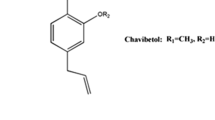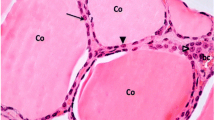Abstract
Catechins, the flavonoids found in abundance in green tea, have many beneficial health effects such as antioxidative, anticarcinogenic, anti-inflammatory, antiallergic, and hypotensive properties. However, flavonoids have antithyroid/goitrogenic effect, although less information is available about the effect of pure catechin on thyroid physiology. The present investigation has been undertaken to explore the effect of catechin administration on thyroid physiology in rat model. For the in vivo experiment catechin was injected intraperitoneally (i.p.) at doses of 10, 20 and 30 mg/kg body to male albino rats for 15 and 30 days, respectively, and thyroid activities were evaluated with respect to determination of serum levels of thyroid hormones, thyroid peroxidase, 5′-deiodinase I (5′-DI), and Na+, K+-ATPase activities that are involved in the synthesis of thyroid hormone. Catechin decreased the activities of thyroid peroxidase and thyroidal 5′-deiodinase I, while Na+, K+-ATPase activity significantly increased in dose-dependent manner; substantial decrease in serum T3 and T4 levels coupled with significant elevation of serum TSH were also noted. Histological examinations of the thyroid gland revealed marked hypertrophy and/or hyperplasia of the thyroid follicles with depleted colloid content. In in vitro study, short-term exposure of rat thyroid tissue to catechin at the concentrations of 0.10, 0.20, and 0.30 mg/ml leads to decrease in the activities of thyroid peroxidase and 5′-deiodinase I, while the activity of thyroidal Na+, K+-ATPase remains unaltered even at high concentration of catechin treatment. The present study reinforces the concept that catechin, tea flavonoids possess potent antithyroid activity as evidenced from in vivo and in vitro studies.







Similar content being viewed by others
Abbreviations
- ANOVA:
-
Analysis of variance
- BSA:
-
Bovine serum albumin
- BTE:
-
Black tea extract
- COMT:
-
Catechol-O-methyltransferase
- DIT:
-
Diiodotyrosine
- DMSO:
-
Dimethylsulfoxide
- DTE:
-
Dithioerythritol
- EC:
-
(−)-Epicatechin
- ECG:
-
(−)-Epicatechin gallate
- EDTA:
-
Ethylenediamine tetraacetic acid
- EGC:
-
(−)Epigallocatechin
- EGCG:
-
(−)-Epigallocatechin gallate
- ELISA:
-
Enzyme-linked immuno sorbent assay
- GTC:
-
Green tea catechins
- GTE:
-
Green tea extract
- GTP:
-
Green tea polyphenols
- H&E:
-
Hematoxylin & Eosin
- H2O2 :
-
Hydrogen peroxide
- MIT:
-
Monoiodotyrosine
- MTT:
-
3-(4,5-Dimethylthiazol- 2-yl)-2,5-diphenyltrazolium bromide
- Na+, K+-ATPase:
-
Sodium, Potassium Adenosine Triphosphatase
- Na2ATP:
-
Adenosine-5′-triphosphoräure Dinatriumsalz
- NIDDK:
-
National Institute of Diabetes and Digestive and Kidney Diseases
- NIS:
-
Sodium-Iodide Symporter
- PTU:
-
Propylthiouracil
- RIA:
-
Radioimmunoassay
- rT3:
-
Reverse T3
- SDS:
-
Sodium dodecyl sulfate
- T3:
-
Tri-iodothyronine
- T4:
-
Thyroxin
- TBG:
-
Thyroxine-binding globulin
- TPO:
-
Thyroid peroxidase
- TRH:
-
Thyrotropin-releasing Hormone
- Tris-ATP:
-
Hydroxymethyl Aminomethane Hydrochloride Adenosine Triphosphate
- TSH:
-
Thyroid stimulating hormone
- 5′-DI:
-
5′-Monodeiodinase-I
References
Katiyar SK, Mukhtar H (1996) Tea in chemoprevention of cancer: epidemiologic and experimental studies (review). Int J Oncol 8:221–238
Graham HN (1992) Green tea compostion, consumption, and ployphenol chemistry. Prev Med 21:334–350
Molinari M, Watt KD, Kruszyna T (2006) Acute liver failure induced by green tea extracts: case report and review of the literature. Liver Transpl 12:1892–1895
Chow HH, Cai Y, Hakim IA, Crowell JA, Shahi F, Brooks CA, Dorr RT, Hara Y, Alberts DS (2003) Pharmacokinetics and safety of green tea polyphenols after multiple-dose administration of epigallocatechin gallate and polyphenon E in healthy individuals. Clin Cancer Res 9:3312–3319
Chengelis CP, Kirkpatrick JB, Regan KS, Radovsky AE, Beck MJ, Morita O, Tamaki Y, Suzuki H (2008) 28-Day oral (gavage) toxicity studies of green tea catechins prepared for beverages in rats. Food Chem Toxicol 46:978–989
Chacko SM, Thambi PT, Kuttan R, Nishigaki I (2010) Beneficial effects of green tea: a literature review. Chin Med 5:13–21
Wang CC, Chu KO, Chong WS, Li WY, Pang CP, Shum AS, Lau TK, Rogers MS (2007) Tea epigallocatechin-3-gallate increases 8-isoprostane level and induces caudal regression in developing rat embryos. Free Radic Biol Med 43:519–527
Imai T, Takami S, Hasumura M, Cho Y-M, Onose J, Hirose M (2008) Evaluation of toxicity of green tea catechins with 90-day dietary administration to F344 rats. Food Chem Toxicol 46:2224–2229
Lindsay RH, Gaitan E, Cooksey R (1989) Pharmacokinetics and intra-thyroidal effects of flavonoids. In: Gaitan E (ed) Environmental goitrogenesis. CRC Press, Bocu. Roton. FL, pp 43–56
Gaitan E, Cooksey RC, Lagan J, Lindsay RH (1995) Antithyroid effects in vivo and in vitro of vitexin: a C-glycosylflavone in millet. J Clin Endocrinol Metab 80:1144–1147
Chandra AK, Mukhopadhyay S, Ghosh D, Tripathy S (2006) Effect of radish (Raphanus sativus Linn.) on thyroid status under conditions of varying iodine intake in rats. Ind J Exp Biol 44:653–661
Ferreira ACF, Rosenthal D, Carvalho DP (2000) Thyroid peroxidase inhibition by Kalanchoe brasiliensis aqueous extract. Food Chem Toxicol 38:417–421
van der Schroder-Elst JP, van der Heide D, Kohrle J (1991) In vivo effects of flavonoid EMD 21388 on thyroid hormone secretion and metabolism in rats. Am J Physiol 261:E227–E232
Koehrle J (2000) Flavonoids as a risk factor for goiter and hypothyroidism. In: Peter F, Wiersinga W, Hostalek U (eds) The Thyroid and Environment. Schattauer, Stuttgart, pp 41–63
Sakamoto Y, Mikuriya H, Tayama K, Takahashi H, Nagasawa A, Yano N, Yuzawa K, Ogata A, Aoki N (2001) Goitrogenic effects of green tea extract catechins by dietary administration in rats. Arch Toxicol 75:591–596
Satoh K, Sakamoto Y, Ogata A, Nagai F, Mikuriya H, Numazawa M, Tayama K, Aoki N (2002) Inhibition of aromatase activity by green tea extract catechins and their endocrinological effects of oral administration in rats. Food Chem Toxicol 40:925–933
Chandra AK, De N, Roy Choudhury S (2010b) Effect of different doses of un-fractionated green & black tea extracts on thyroid physiology. Human Exp Toxicol 30:884–896
Alexander NM (1962) A spectrophotometer assay of iodine oxidation by thyroid peroxidase. Anal Biochem 4:341
Esmann M (1988) ATPase and phosphate activity of Na+, K+-ATPase: molar and specific activity, protein determination. Methods Enzymol 156:105–115
Baginski ES, Foa PP, Zak B (1967) Determination of phosphate: study of labile organic phosphate interference. Clin Chim Acta 15:155–158
Ködding R, Fuhrmann H, von zur Mühlen A (1986) Investigations on Iodothyronine deiodinase activity in the maturing rat brain. Endocrinology 118:1347–1352
Lowry OH, Rosebrough NJ, Farr AL, Randall RJ (1951) Protein measurement from phenol reagent. J Biol Chem 193:265–270
Greenwood FC, Hunter WM, Glover JS (1963) The preparation of 131I-labelled human growth hormone of high specific activity. Biochem J 89:114–123
Corvilain B, Collyn L, van Sande J, Dumont JE (2000) Stimulation by iodide of H2O2 generation in thyroid slices from several species. American J Physiol Endocrinol and Metab 278:E692–E699
Roger P, Taton M, Van Sande J, Dumont JE (1988) Mitogenic effects of thyrotropin and adenosine 30,50- monophosphate in differentiated normal human thyroid cells in vitro. J Clinical Endocrinol Metab 66:1158–1165
Gaitan E, Cooksey RC, Matthews D, Presson R (1983) In vitro measurement of anti-thyroid compounds and environmental goitrogens. J Clin Endocrinol Metab 56:767–773
Biswas SK, Sodhi A, Paul S (2001) Regulation of nitric oxide production by murine peritoneal macrophages treated in vitro with chemokine monocyte chemoattractant protein 1. Nitric Oxide 5:566–591
Fisher RA, Yates R (1974) Statistical Tables for Biological. Agricultural and Medical Research, Longman Group
Klaus S, Pültz S, Thöne-Reineke C, Wolfram S (2005) Epigallocatechin gallate attenuates diet-induced obesity in mice by decreasing energy absorption and increasing fat oxidation. Int J Obes Relat Metab Disord 29:615–623
Murase T, Nagasawa A, Suzuki J, Hase T, Tokimitsu I (2002) Beneficial effects of tea catechins on diet-induced obesity: stimulation of lipid catabolism in the liver. Int J Obesity 26:1459–1464
Nagao T, Hase T, Tokimitsu I (2007) A green tea extract high in catechins reduces body fat and cardiovascular risks in humans. Obesity 15:1473–1483
Kao Y, Hiipakka RA, Liao S (2000) Modulation of obesity by green tea catechins. Am J Clin Nutr 72:1232–1233
Ishihara K, Ito Y, Ichikawa T, Morohoshi Y, Nakamura T, Saegusa Y (2008) Effect of tea catechins on body fat accumulation in rats fed a normal diet. Biomed Res 29:27–32
Divi RL, Doerge DR (1996) Inhibition of thyroid peroxidase by dietary flavonoids. Chem Res Toxicol 9:16–23
Divi RL, Chang HC, Doerge DR (1997) Anti-thyroid isoflavones from soybean: isolation, characterization, and mechanism of action. Biochem Pharmacol 54:1087–1096
Chandra AK, De N (2010) Goitrogenic/antithyroidal potential of green tea extract in relation to catechin in rats. Food Chem Toxicol 48:2304–2311
Köhrle J (1999) Local activation and inactivation of thyroid hormones: the deiodinase family. Mol Cell Endocrinol 151:103–119
Ferreira AC, Lisboa PC, Oliveira KJ, Lima LP, Barros IA, Carvalho DP (2002) Inhibition of thyroid type 1 deiodinase activity by flavonoids. Food Chem Toxicol 40:913–917
Spitzweg C, Morris JC (2002) Sodium Iodide Symporter (NIS) and Thyroid. Hormones 1:22–34
Chow SY, Kemp JW, Woodbury DM (1982) Correlation of iodide transport with Na+, K+-ATPase, HCO3 “-ATPase and carbonic anhydrase activities in different functional states of the rat thyroid gland. J Endocrinol 92:371–379
Kundu S, Pramanik M, Roy S, De J, Biswas A, Ray AK (2006) Maintenance of brain thyroid hormone level during peripheral hypothyroid condition in adult rat. Life Sci 79:1450–1455
Pressley TA, Higham SC, Joson LA, Mercer DW (1995) Stimulation of Na+, K+ ATPase by thyrotropin in cultured thyroid follicular cells. Am J Physiol Cell Physiol 268:1252–1258
Le Grow AB, Fielding DC, Pressley TA (1999) Stimulation of Na+, K+-ATPase by hypothyroidism in the thyroid gland. J Endocrinol 160:453–460
Do¨hler KD, Wong CC, von zur Mu¨hlen A (1979) The rat as model for the study of drug effects on thyroid function: consideration of methodological problems. Pharmacol Ther 5:305–318
Capen CC (1995) Toxic response of the endocrine system. In: Klaassen CD, Amudr MO, Doull J (eds) Casarett and Doull’s toxicology: the basic science of poisons. Barnes and Noble, McGraw-Hill, New York, pp 617–640
Acknowledgments
Acknowledgement is due to the National Tea Research Foundation (NTRF), Kolkata, India, for providing fellowship to Neela De for this work. The authors are grateful to Prof. Arun K. Ray (Bose Institute, India) for his contribution in conducting enzyme study. The authors thank Dr Syed N Kabir, Scientist, Cell Biology & Physiology Division, Indian Institute of Chemical Biology (IICB), Kolkata, India, for his help in conducting RIA of TSH.
Author information
Authors and Affiliations
Corresponding author
Rights and permissions
About this article
Cite this article
Chandra, A.K., De, N. Catechin induced modulation in the activities of thyroid hormone synthesizing enzymes leading to hypothyroidism. Mol Cell Biochem 374, 37–48 (2013). https://doi.org/10.1007/s11010-012-1503-8
Received:
Accepted:
Published:
Issue Date:
DOI: https://doi.org/10.1007/s11010-012-1503-8




